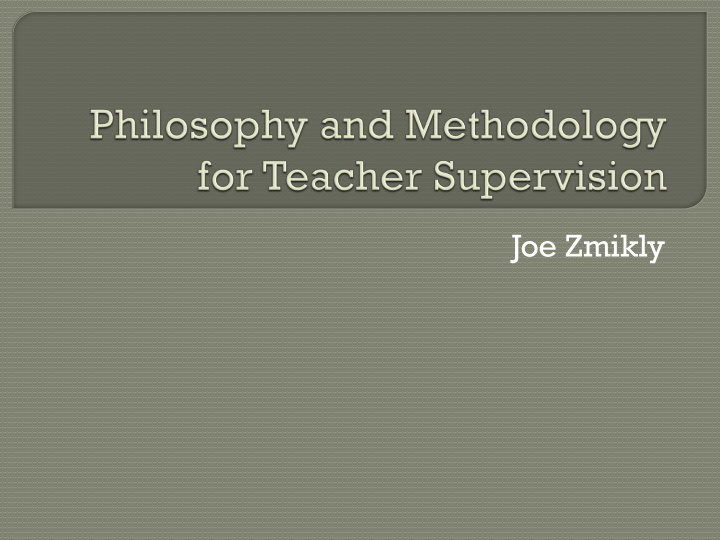



Joe Zmikly
• Based on Teacher Evaluation: A Study of Effective Practices (1984) by Wise, Darling-Hammond, McLaughlin, & Bernstein 1. Principals often lack sufficient resolve and competence to evaluate accurately 2. Lack of uniform evaluation practices 3. These often lead to teachers being resistant to feedback 4. Lack of training for evaluators
Visible Learning (2009) and Visible Learning For Teachers (2012) , by John Hattie The Art and Science of Teaching (2007) and Effective Supervision (2011) , by Robert Marzano “I’m deeply troubled by the transformation of teaching from a complex profession requiring nuanced judgment to the performance of certain behaviors that can be ticked off a checklist.” – Charlotte Danielson
15 Years of Research 800+ Meta Analyses* 50,000 Studies 260+ Million Students Almost any intervention has a positive impact, but… Which factors have the greatest impact on student learning? * Continued research includes over 1,000 Meta Analyses
Teaching as both an art and a science 60 specific elements across 4 domains of teaching expertise Emphasis on practices to support teachers to improve their skills
Student Achievement is the ultimate goal Teacher is the primary facilitator of student achievement Principal’s role is to support teacher to improve professional practices
1. Well-Articulated Knowledge Base for Teaching 2. Focused Feedback and Practice 3. Opportunities to Observe and Discuss Expertise 4. Clear Criteria and a Plan for Success 5. Recognition of Expertise
Domain 4 : Collegiality and Professionalism Domain 3 : Reflecting on Teaching Domain 2 : Planning and Preparing Domain 1 : Classroom Strategies & Behaviors STUDENT ACHIVEMENT Domain 4 : Collegiality and Professionalism
Almost exclusively based on Formal Observations of Elements articulated in Condition #1 This is a misuse of Marzano’s Model
1. Establish Shared Knowledge Base for Teaching and Learning 2. Provide for focused practice and feedback Teacher self-reflection & goal-setting • Principal observe current practices – walk- • throughs, informal sit-ins, formal sit-ins and provides pointed feedback 3. Opportunities to observe and discuss 4. Principal and teacher collaborate to evaluate teacher’s growth and proficiency
1. Well-Articulated Knowledge Base for Teaching Over time, become familiar with Marzano’s • Elements of Teaching, Hattie’s Dimensions of Expert Teachers, etc. Teachers Self-Assess current practices in order • to set meaningful goals
2. Focused Feedback and Practice Teachers reflect on current practices with regard to • Marzano’s elements of teaching Teachers select one Element for focused practice • and feedback and create a Goal/Personal Plan, and Principal provides a broad, schoolwide goal Principal’s focus during informal observations will • be those goals, to provide pointed feedback and support Lots of Observation – walk-throughs, informal sit- • ins, and formal observations
3. Opportunities to Observe and Discuss Expertise • “If teachers can not observe other classrooms, their method of generating new knowledge about teaching is limited to personal trial and error” – Marzano • This is the only aspect not supported by the history of supervision and evaluation
4. Clear Criteria and a Plan for Success • Student Achievement Data • Clear Rubrics for Elements of Teaching • Individualized Growth Plans, developed by teacher, approved and supported by principal
5. Recognition of Expertise • Research indicates that regardless of the field, 10 years of deliberate practice is need to reach “expert status”
Student Achievement is the ultimate goal Research has identified certain teacher practices as having a positive effect on student achievement Principal’s role is to help teacher improve their craft through: • Shared beliefs about teaching and learning • Goal-setting process • Freedom to practice new ideas and methods • Frequent observation and feedback • Opportunities for professional development and to observe other teachers and discuss
Recommend
More recommend